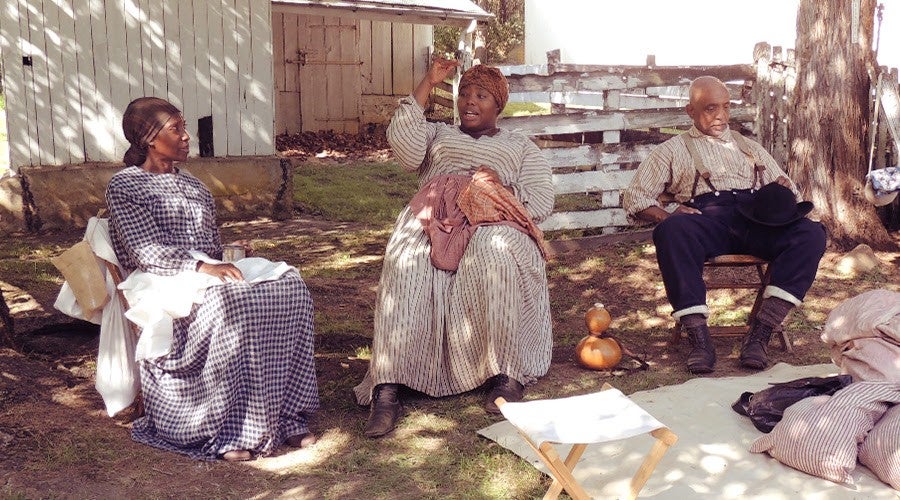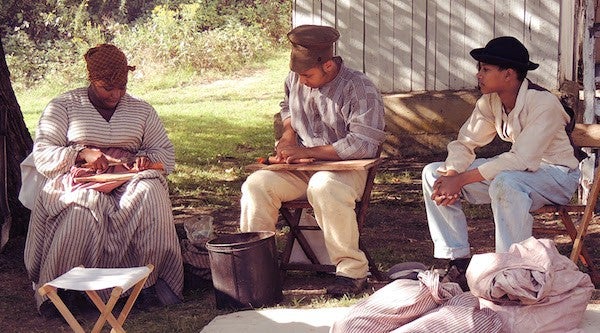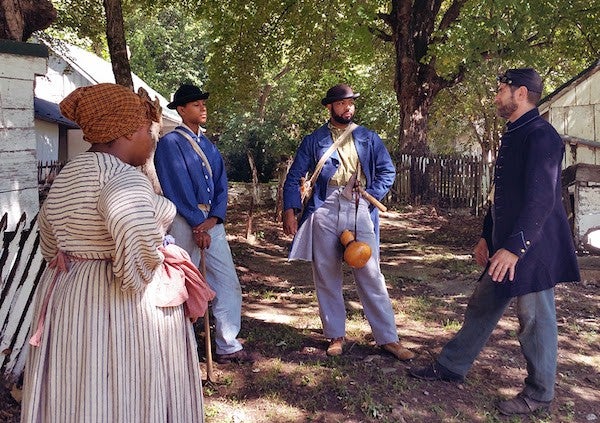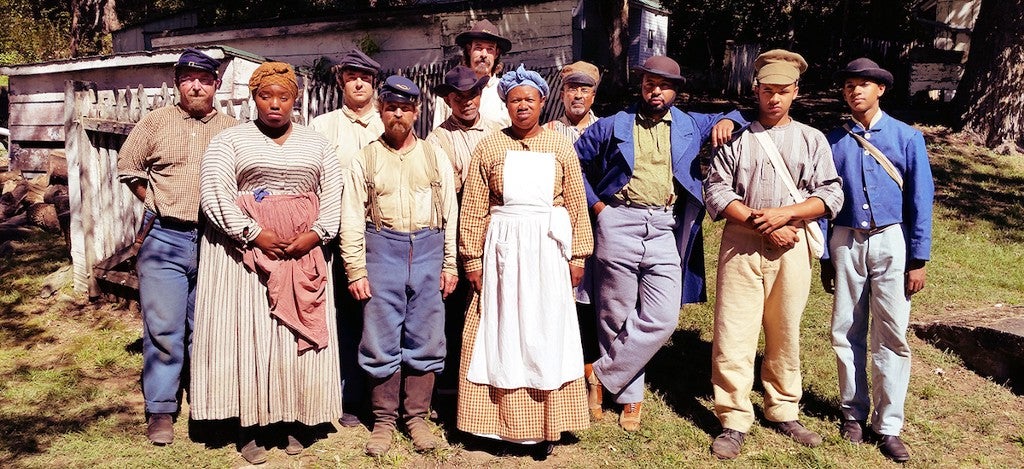Sitting on a stump beneath an old oak tree, beside a weathered barn in Sharpsburg, Maryland, a black man in a homespun woolen shirt and threadbare breeches butchers a turkey with a dull blade. His name is Marvin Greer; he is 29 years old. Around him, seven other African Americans, all of them wearing the period garb of freemen and liberated slaves — cotton dresses, straw hats and antique bonnets — go about the business of preparing breakfast for a dozen white men in blue Union uniforms who are bivouacked just downstream, a 19th-century tintype come to life.
Greer rode a bus 14 hours from Atlanta to participate in this Civil War re-enactment deep in the mountains near Maryland’s border with West Virginia, hard against the Potomac River. It’s breakfast time, and he’s part of the cooking detail. Bacon and onions sizzle in a cast-iron skillet along with apples and yams; a tin pot of coffee boils over, releasing fragrant plumes of smoke into the morning air.
A graduate of traditionally black Morehouse College in Atlanta, Greer has embraced history as more than just a major. Currently a part-time employee of the Atlanta History Center, he is paid to dress up as a slave and re-enact Southern history. Recently he landed a full-time job at Colonial Williamsburg, where he will exchange the garb of a slave for the knee-breeches and waistcoats of a freeman. As a site supervisor, at the Williamsburg, Virginia, theme park, Greer will be charged with integrating the African-American experience into the 18th-century programming.
On this warm September morning, Greer is on his own time, pursuing what many would consider an unusual hobby. He spends his weekends trekking to battlefields across the Southeast. Sometimes he shoulders a musket as an enlisted man in the Union Army — which employed freedmen as soldiers in the War Between the States. Other days, he’s simply a laborer, bearing witness to the approximation of history.
Today Greer is playing a real historical figure named Scipio Africanus, who was born free in Harper’s Ferry, Virginia, in the mid-19th century. When the Civil War broke out, according to Greer’s research, Africanus left his family to become a body servant to Captain Francis Adams Donaldson of the 118th Pennsylvania, part of the U.S. force pressed into action by Abraham Lincoln to fight against the rebels. On this day 153 years ago, the 118th was pursuing Confederate forces along this route as they retreated southward from their defeat on the bloody battlefield in nearby Antietam.
Though Africanus likely never kept a journal — one has never been found, and his ability to read and write was probably limited, Greer says — he is mentioned in Donaldson’s meticulously kept logs, which state that Africanus was here with the captain more than 150 years ago. The diary contains only a passing description of Africanus as a “sassy nigger,” so in order to fill out the servant’s spitfire personality, Greer has incorporated elements — vernacular, backstory and even posture — of other freemen he’s researched from the area and time period. For instance, Africanus most likely would’ve camped with the other African Americans, most of them newly liberated from a nearby plantation.
The turkey starts to crackle in the pan. “There’s an upside of being in a Union camp,” Greer says with an amused smile, stirring the mix with a corroded two-tine fork. “They eat a lot better than the Confederates.”
At home in his one-bedroom apartment in downtown Atlanta, Greer’s closet holds a period wardrobe spanning more than a century of styles, from the 1840s to the 1960s — with an emphasis on the Civil War era of the 1860s. When period pieces prove too rare, expensive or fragile to wear, he buys handcrafted reproductions online. In all, he estimates, he’s sunk about $10,000 into historical costumes and accessories. “That’s a major factor in choosing a place to live,” Greer says. “It has to have enough closet space.”
If Greer can’t literally put himself in the skin of someone long past, he can at least replicate the clothes they wore. By getting into character, by re-enacting history as it really happened, he hopes, the forgotten truths of the past can re-emerge.
Dressed as Africanus, or as any other of the men he has portrayed, Greer says he is afforded the ability to get a little closer to history than one could get only with books, historical papers and relics. Wearing the clothes, walking the walk, Greer gets a gut feeling of what things were really like. “I want to challenge myself,” Greer says. “I always wonder: Could I have lived in the 19th century?”

Greer’s fascination with American history — and the role African Americans have played in it — began when he was young. The son of a real-estate developer and an assistant principal, raised in Pasadena, California, he often spent his summers with his grandparents in Pittsburgh, where a neighbor regaled him with stories of her late husband, a lieutenant in a segregated Army unit during World War II. In appreciation of his rapt attention, the neighbor gifted Greer with a trove of her husband’s artifacts — hats, shirts, even his Army uniform. As the young Greer ran his fingers along the worn stitching and buried his nose in the musty cloth, he was transported to another time, as if the drab fabric had absorbed traces of this stranger’s life. It was the beginning of his life as a historian.
Greer became interested in the Civil War after completing a grade-school project on Gettysburg. Repeated viewings of Glory, the 1989 film about the first all-black regiment to fight for the Union, stoked his curiosity. In 2001, as a 15-year-old, he attended his first Civil War re-enactment battle.
But the early re-enactments Greer watched were somewhat appalling to him. They seemed less like historical reproductions and more like free-for-alls dedicated to the glorification of an idealized, stars-and-bars culture of the vanquished South. Most of the re-enactors Greer encountered seemed more interested in shooting muskets, drinking booze and raising hell than actually representing history. Greer remembers some events where the Southern forces were allowed to win battles that they’d actually lost, just to “keep things fair.” “Rewriting history to make other people comfortable is pretty much what tyrants have done throughout time,” Greer says. “It’s a gross injustice.”
In Greer’s mind, this revisionist take on history was more or less condoned by the absence of other African-American faces at re-enactments. In fact, there were some 179,000 African Americans who served in the Union Army during the Civil War — including eight men from Greer’s own family tree. It was alarming to Greer that even as Civil War culture was being maintained and exalted, the stories of his ancestors, both enslaved and free, had been neglected and lost to time. As had some of the lessons learned by society in the years since.
Early in his hobby, Greer portrayed an enslaved laborer during the siege of Fort Sumter in Charleston. He stopped his work to cheer for the approaching Union troops — only to be shouted down as a “nigger” by an overzealous redneck in gray. “I was at a loss for words,” Greer says. “Something like that had never happened to me before. I was horrified. I didn’t know how to respond.” Looking back, Greer says he was ashamed by his own lack of reaction.

The more experienced Greer now calmly confronts these offenders. His job, after all, is to enlighten. “I’ve realized that I need to speak out,” he explains. “Because my ancestors weren’t able to.”
A few years ago, through an online acquaintance, Greer met George Hardy, a retired Xerox account executive who has been doing re-enactments for 25 years. Hardy had assembled an informal troupe of African-American re-enactors from all over the country. Today, he, Greer and a shifting cast of about a half-dozen others call themselves “The Sons and Daughters of Ham,” Noah’s son, whose offspring, according to the Hebrew Bible, populated Africa. They rendezvous at Hardy-approved events like this one, where together they can better represent the African-American perspective of this turbulent period in American history — for public onlookers, white re-enactors and each other.
Slavery, says Hardy, is “the 800-pound gorilla in the room. You can’t talk about the Civil War without slavery, and yet no one will talk about it. These re-enactments are the best chance we have to educate. A picture is worth a thousand words. When we’re dressed up at these events, people walk up and want to talk, to engage instead of believing what they’ve been told.”
When most people think of a Civil War re-enactment, they envision the battles — the blast of a cannon and the pop of musket blanks, men falling and feigning death beneath a veil of spent-powder smoke. But between the clashes of arms that are highlighted in the history books, there were the long lulls of everyday life. To Greer and his fellow re-enactors, that’s the real history.
This event in Sharpsburg, set on a wooded hill facing the Chesapeake and Ohio Canal, is intended to portray a living history of one of those interim days, a day between battles when the intricacies of daily life as a combatant can be better explored. The participants are separated into three stations, which the public can visit. Station One is the cooking camp of Greer and Hardy’s freemen. At Station Two, black laborers are dispatched to fix damage done to the canal by the fleeing rebels. Station Three is where the dozen Union troops of the 118th are regrouping after a successful battle — cavorting, smoking, reading period newspapers and napping on bedrolls down by the river.
Greer as Africanus is dressed in gray wool socks, stiff-soled leather-and-canvas camp shoes, cotton drawers, jean-cloth trousers held up by suspenders, a thick red woolen overshirt and a straw cap tipped askew. The layers are designed to protect him from mosquitos; the heat by the campfire is intense beneath the late-summer sun.

When he’s finished cleaning up breakfast and soaking the dirty plates and cutlery in a tub, Greer shoulders a pickaxe and makes his way down to the canal as part of the Station Two repair detail. Because the long-defunct canal is now just a dry, grassy ditch that no longer needs repair, Greer and two cohorts while away the midday hours stretched out on the ridge, looking out over the mountains, snacking on apples and braised rabbit in the shade while cars pass by — a few of which feature decals of the Confederate stars-and-bars.
Over the course of the afternoon hours, only a few curious hikers and cyclists stop on the towpath trail to engage Greer and his fellows. When they do, the workers quickly rise and assume the roles of their characters, like museum exhibits come to life.
At least this is what happens when an elderly white couple approaches. Out for what appears to be a routine constitutional, they’re a little baffled to run into a bunch of people in period garb.
“How’s the war going for you all?” Greer asks, staying in character.
The couple looks at him like he’s crazy, but Greer sees a chance to educate, gazing down at the couples’ feet, pale beneath the straps of their sandals. To a time traveler from the 1800s, sandals like these wouldn’t be an everyday item — rather, to someone from the past, they might appear to be the tattered remains of shoes.
Greer points to the sandals. “Obviously you’re not doing too well,” he says seriously. “Your shoes are falling apart.”
The couple forces a laugh and Greer smiles affectionately. In time, a dialogue about the role of free-slaves during the Civil War begins.
“You want people to get to that point where a lightbulb goes off,” Greer says. “Seeing what we do, people start to understand what really happened in history.”
As the sun sets beyond the Potomac and the foot traffic on the towpath trickles to a stop, the faux-canal workers and the dozen troops of the 118th Pennsylvania are called to supper at the camp.
Greer ladles white beans and pork from a bubbling pot. There is also corn on the cob and home-baked hard tack from Hardy’s own kitchen. Because it’s 2015, and modern laws of respect are always in effect, each white soldier goes out of his way to express his thanks to Greer and the other cooks. When seconds have been had, the colonel breaks historical protocol and orders the white guys to handle the dishes.
Afterward, all of the re-enactors, black and white, gather by the fire. The soldiers pass around tin cups of Hooker’s Retreat, a mix of whiskey, sugar and a pinch of nutmeg that one of the officers had found mention of in a book about the Army of the Potomac. A stout, bespectacled infantryman sits down on a wooden folding chair, lifts a fiddle and starts sawing away at a 19th-century reel.
Greer stands by the fire, relaxing on his feet. Even when re-enactment is done right and the whites are polite, Greer is still inhabiting the life of a slave. “It takes a while to decompress after being treated all day as a second-class citizen or even a sub-human by people you consider friends and colleagues,” he says.
Greer sees his activities as part of a long continuum that started in the 1500s, when Africans were first brought to this land in chains, and that’s still going on today, with movements like Black Lives Matter. As crucial as he considers the job of educating others about the milestones and nuances of African-American history, it’s perhaps even more important to Greer to feel, smell and see that history firsthand. “I get to go home to a hot shower and an air conditioner,” he says. “No matter what I go through, it’s nothing compared to what my ancestors went through.”
Now Greer moves around the circle and takes a seat beside the fiddler. From his hip pocket he pulls out a set of wooden bones — a pair of sticks about the size of chicken legs. He slaps them together to keep time.
As he gets into the rhythm, Greer makes a mental note: Not so long ago, the people around this fire would have been segregated — there would never have been both blacks and whites sharing music and an agreeable evening beneath the stars.
It’s a little piece of revisionist history he can live with.
